
Second in the Magic Metrics Series, the classic 7×57 Mauser was one of the first small bore cartridges to begin the smokeless powder revolution. Rifles would never be the same after then. Here is a comprehensive look at this great “all around” small bore, big game cartridge.
I have been aware of the 7×57 cartridge since my shooting career first began through early readings on shooting and hunting. It was made famous by some colorful elephant hunters back when hunting in Africa by the white man was just beginning in the late 1800’s and early 1900’s. The very slender, but heavy for caliber, full metal jacketed bullets were renowned for giving tremendous penetration on game up to and including the thick skinned pachyderms of the Dark Continent. Since I was a modern shooter, living in America, it never really caused any stirrings deep inside, drawing me to seek out a rifle in this modest cartridge. Instead, I jumped on the high-velocity bandwagon and never even looked back at this little 7mm cartridge, until now. Let me state that I am glad I finally “discovered” it, for indeed it does still serve a very valuable position in the hunting fields. A cartridge which survives well past one-hundred years can only hang around if it serves a purpose. It did not take me long at all to find this out once I began to work with it, and shoot it, and shoot it.
Chapter 1: The Cartridge and Rifle
Click for LOAD DATA SHEET
Not very large of bore and most unimpressive by looks alone, what can the simple little 7×57 have going for it? As discovered ages ago, long for caliber bullets of modest velocity penetrate all out of proportion to their size in both small and large game. The relatively small case capacity results in low recoil and muzzle blast, both of which contribute to easy and friendly shootability. The beginning shooter or a seasoned veteran will both realize great success in the hunting field because modest recoil promotes good shooting, which results in successful hunts.
It is quite easy to place an accurate shot when the shooter is not concerned about having his teeth shaken loose by a rifle that kicks and bellows like an artillery piece. As a shooter, I found it very easy to concentrate on shooting tiny groups with this 7mm...
cartridge. The ability to place well constructed, long for caliber bullets where you want them can put game on the ground each and every time the trigger is pulled. The 7×57 is still around because it works today just as well as it did long ago in the field.
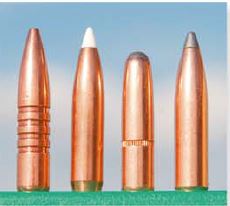
Out of respect for this grand old cartridge, I choose a rifle without a bit of plastic or fiberglass in it anywhere. It is a “gentleman’s rifle” in every sense of the word, classic in appearance and function. The Ruger #1 International is a fitting rifle to chamber in the 7×57 cartridge. It sports a medium weight 20” barrel, a full length forend, extending to a graceful ramped front sight and muzzle cap. Due to the compactness of the falling block design, it is almost 4 inches shorter than my 20” barreled Steyr Mountain rifle in 7mm-08, making it a joy to carry for a trek in the mountains, or a delight to handle in the close confines of a stand overlooking a lush grass meadow, or shooting lane cut back cleanly into a heavy forest. It also is very easy on the eyes; personally, one of the most handsome rifles with which I have ever worked. I did not bother to measure the trigger pull, as it felt crisp and clean to me for a hunting rifle. I did not weigh and measure it. I only need to say that it is a joy to look at and point… making me want to go into the field or forest to hunt, for the simple truth is, this is a hunter’s rifle. It was topped with an appropriate Leupold VX-III in 2.5-8 power in Ruger double set-back 1” rings. Due to the scope mounting rib’s position in front of the action, I have always needed the double set-back rings to bring the scope back into proper eye position; the standard rings shipped with the rifle have never worked properly for me.
I had very low expectations as to the accuracy that could be delivered by a single shot rifle, sporting a two-piece stock which extended clear to the muzzle of a short hunting barrel. Testing right from the start proved me to be very, very wrong. How Ruger hangs the forend, how they address the muzzle cap and the barrel contact points, I may
never know. From the first trip to the range to the very last, I was stunned with how well this rifle shot. I did not touch the forend ever to...
see what Ruger had done; just rest assured knowing that whatever they did, it works!
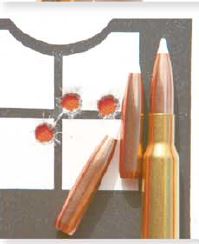
My first groups out of this Number 1, the very last group, and many in between, were the size of a coin, a very small coin. Typically, two shots would touch, and one would be just a short distance away. It was not always the first two or last two shots that would seemingly make it into a single ragged hole with a third just a short distance away. There was no rhyme or reason to it, but consistently I was tantalized by having two shots touch and a third shot a short distance from the other two. Just keep in mind that the averaged group sizes you see include the “flier” that occurred perhaps 30 to 50% of the time on paper. Game would never know this though, and that is what really matters in a hunting rifle.
Chapter 2: Reloading Components Tested
In 7mm, hunters are blessed with a broad range of weights and constructions in bullets allowing one to match the load with the game being taken. Surely, one or more of these bullets would allow the hunter to take almost all non-dangerous game anywhere in the world. Reloading was performed using Redding FL dies and their Ultra-Mag single stage press. Over eighty powder and bullet combinations were tested at the range. Charges were thrown and weighed using the RCBS ChargeMaster powder dispensing system. The QuickLOAD ballistic...
reloading program was used to help guide me with beginning loads. I also checked this baseline against published load data for the bullets and powders to be tested. Keep in mind that if your rifle has a shallow throat, requiring bullets to be seated deeper than shown, the charges have to be reduced by 10% and then worked up slowly from there.
Chapter 3: Results and Recommendations
A very pleasant surprise- would best describe the accuracy performance of the short and lightweight 100-grain hollow point bullet from Hornady. The first full-power load I tried with IMR 4895 broke 3,280 fps and shot into 0.74”. Great very low recoil practice loads were easily developed using both Alliant Blue Dot and Accurate 5744 powders. Only 24-grains of Blue Dot matched the accuracy of the above full-power load but delivered a fraction of the recoil- making for an excellent practice load. A real eye-opener was the load using 35 grains of Accurate 5744, which shot into only 0.39”. This would make a real confidence building round for a young shooter or the recoil conscious who just wanted to sharpen their shooting skills.
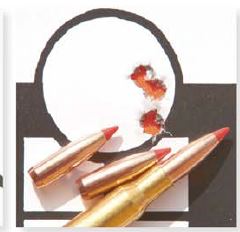
Excellent practice loads were also found using 5744 under 120-grain bullets; either the Barnes TSX or the Nosler Ballistic Tip. Both bullets would be great for taking smaller big game with minimal muzzle blast and recoil. For hunting light to medium game with the Barnes, Accurate 4350, IMR 4350 or Winchester 760 powders delivered around 3,000 fps and gave great accuracy in the 0.45 to 0.68” range. At around 3,100 fps, the top loads using IMR 4895 or Vihtavuori N550 still shot very well at 0.85”. For years, I loaded the 120-grain X-Bullet in short barreled, light hunting rifles in Montana. Both deer and pronghorn antelope were taken with never a bullet recovered- complete penetration was the norm. Just as accurate, and also capable of great speed from the relatively short barrel, the Ballistic Tips of the same weight also served me well on game. Do keep in mind that the more conventional construction of the Nosler bullet will not retain weight and penetrate as deeply in game as the solid copper TSX.
For some reason, the 139 and 154-grain...
Hornady InnerBonds did not group as well as some others in this particular rifle. Shooting into 1-1/4” is still plenty good for big game hunting, just not in the same class as the performance turned in by other projectiles. The bonded core construction still makes for excellent game performance, and for that reason alone is worth trying in your rifle for accuracy. While the 140 TSX and AccuBonds were not fussy in regards to the powders loaded under them, both displayed a distinctive preference for IMR 4350. Speed and accuracy showed a worthwhile advantage over the tested factory ammunition. The results with four different powders under the 150-grain Nosler Partition produced very similar speeds and accuracy levels. It would be worth trying each one in your rifle to see if a standout emerges.
Not very racy looking, but again a consistent performer, the traditional 154-grain round nosed bullet from Hornady gave very good accuracy with either N560 or Accurate 4350. At normal hunting ranges, the round nose really gives up very little in down-range performance over a spire point bullet.
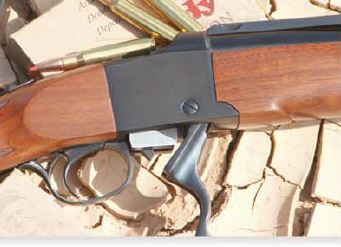
Note that some hunters actually feel that the shape transmits more shock during initial entry into game. The heavier 175-grain brother to this bullet shot just as well and almost as flat while offering more energy and greater penetration. To many hunters, a heavy, round nosed, soft point just feels like the right thing to load in the deep woods when the quarry may only offer a fast and fleeting shot in the brush.
The 160-grain Nosler Accubond provides great velocity and weight retention due to its sleek form and bonded core for hunters after larger game, out to medium ranges. For those wanting to shoot through the biggest game and ensure a good blood trail results from an exit wound, my two hands-on favorites would be either the 160-grain Barnes TSX or the 175-grain Nosler Partition. Looking like they could plow through a lot of bone and muscle, just sitting on my reloading bench, they were capable of delivering great speed from the relatively short barrel of the International Number 1. N560, both types of 4350, and Winchester 760 powders rewarded me with groups running from only ½” to just...
under 1 inch, for 3-shot averages. A hunter of larger game could feel very confident going after elk, moose, or a host of larger African game with either of these two bullets.
Chapter 4: Summary
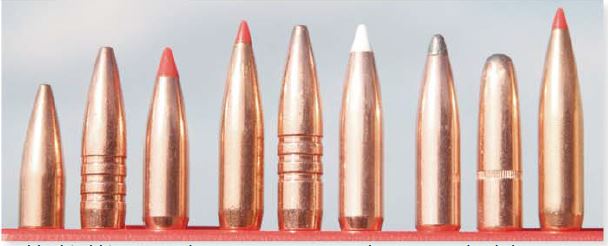
Of the almost fifty loads reported on in this test, only seven combinations shot over 1.10”, and fifteen shot into ¾” or less for averages of at least three, 3-shot groups. For a bolt action rifle, I would consider this very good performance. Considering the Ruger #1 International is a falling block action with a two piece stock with the forend going all the way to the muzzle, I believe this to be exceptional performance.
The velocities delivered by the 7×57 from a mere 20” barrel were very surprising. Considering the distances at which most game is taken, a dedicated hunter would be very well served by carefully choosing from among these many loads, matching bullet weight and construction, to the game being pursued.
With moderate powder consumption delivering velocities more than adequate for the tasks, shooting this 7mm cartridge accurately from the bench was never in question. Light bullet, light powder loads shot very well, as did full power loads with the heaviest, deep penetrating bullets. In all cases, recoil and muzzle blast were never an issue. Nor was the accuracy I was rewarded with on paper. All told, the 7×57 will deliver the goods on paper or in the field. Go to a larger caliber if you like, but the proven performance of good 7mm projectiles is what will anchor game with minimum of fuss to the shooter. It is very easy to see how this over 100 year old cartridge is still going strong.